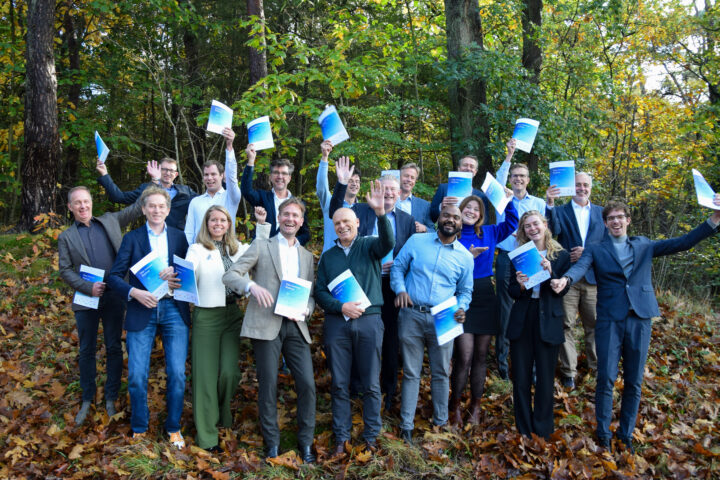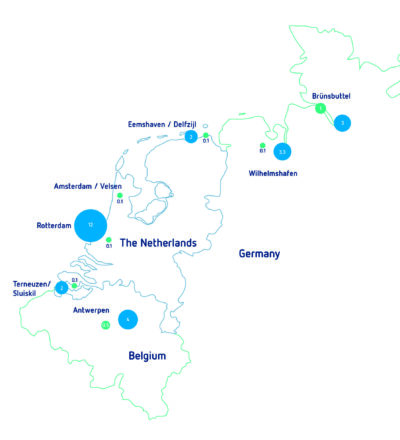The industry recognises the potential of using clean ammonia as a low-carbon energy and hydrogen carrier. Although ammonia has been used in the chemical industry for nearly 100 years, these new industrial-scale value chains present new challenges and opportunities. In collaboration with ISPT, a team of industrial partners within the Clean Ammonia Platform have explored potential market volumes, value chains, and enablers of clean ammonia as an energy and hydrogen carrier in The Netherlands, Belgium and Germany in 2030 and 2050.
This has resulted in the Clean Ammonia Roadmap report, in which a game changing scenario is etched from an industrial perspective. It is suggested that in The Netherlands alone the import of ammonia could increase from about 1 million tonnes per annum today to potentially 16 million tonnes per annum in 2030, including export to Germany.
Potential value chains of clean ammonia
In an effort to reduce its carbon footprint, industry is looking for alternative low-carbon sources to secure its energy supply. Local renewable sources such as wind and PV are not expected to meet demand. Imported hydrogen, produced either green or blue, could provide a reliable source of energy supply. However, hydrogen is costly to store and transport. Ammonia has emerged as a promising hydrogen carrier, boasting a higher energy density and opportunities for more efficient transport and storage in large quantities. At its destination it can be converted back into hydrogen or used directly.
In addition to the existing use of ammonia as a feedstock in chemical industry, clean ammonia can be used directly as a clean fuel in maritime shipping. The Port of Rotterdam is one of the largest bunkering locations in the world and has the necessary infrastructure and expertise to make this possible. Secondly, clean ammonia could be used in retrofitted coal and gas power plants to balance the electricity system from offshore wind and solar. Finally, it can be cracked into hydrogen in steel mills to produce green steel through direct reduction of iron, and in refineries to produce sustainable aviation fuels.
Also intersting to read: our threefold series about clean ammonia:
Part 1 – Ammonia as a new key actor in energy- and material transition
Part 2 – Ammonia’s opportunities for the hydrogen economy
Part 3 – Ammonia: societal benefits, concerns, and safety demands
Ammonia import: 2030 and beyond
These new value chains require investments in import terminals, cracking plants and infrastructure. The forecast of imported ammonia in 2030 is 12 million tonnes per annum for Dutch ammonia demand and 4 million tonnes for export to Germany North-Rhein Westfalia and Baden-Württemberg. In 2050, the estimated import could increase to 43 million tonnes and to 89 million tonnes in total and for the Antwerp-Rotterdam-Rhein Ruhrgebied-Amsterdam (ARRRA). In the Netherlands, shipping would be the dominant sector, while the power sector has a large potential that can be tapped in addition to industrial hydrogen demand.

Safety
As large additional quantities of ammonia import are expected, this requires new legislations and regulations. Careful handling is daily practice in industry, as it has a low odour level and is toxic at higher concentrations and exposure times. Codes and safety standards as such have already been developed for ammonia. New modalities of transport, such as pipelines, will require new and updated safety standards. Guidelines and proper training are needed to ensure safe operation and maintenance of ammonia infrastructure and usage. Therefore, the clean ammonia platform is now initiating a study on pipeline safety requirements.
CO2 reduction potential
The use of zero-carbon ammonia in the power sector alone could contribute to a 28% reduction in CO2 emissions in the Netherlands. In addition, zero-carbon ammonia can reduce CO2 emissions from steel production by 30%. International use of zero-carbon ammonia as a marine fuel could reduce global shipping emissions by 43%. By 2050, clean ammonia has the potential to save around 3% of today’s global CO2 emissions.
This Clean Ammonia Roadmap report is created by the Clean Ammonia Platform (part of ISPT) in close collaboration with the platform partners: Ammonia Energy Association, Duiker Clean Technologies, Horisont Energi, Koole Terminals, Shell, Port of Rotterdam, RVO, ZETA Energy Systems, OCI Global, Deltalinqs, E.ON Essent and HyCC.
